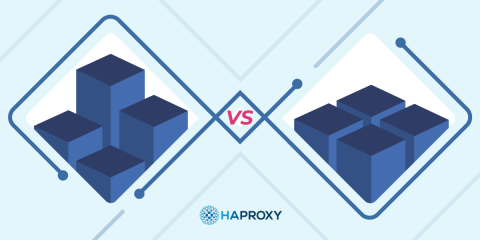
Application acceleration is all about improving the responsiveness of a digital service. When clients access web applications, they are expecting near-immediate feedback from servers. Maintaining that level of performance requires ensuring the right resources are available to process requests, shortening the information retrieval process, and maintaining system uptime by warding off threats. Without application acceleration, one application delivery slowdown (referring to the network transmission of a web application) could snowball into countless others.
What affects application responsiveness?
When information travels between the client and the server, there are sometimes speed traps along the way, affecting the overall responsiveness of your application. These speed traps can arise due to various reasons:
The geographical distance of the client to the server. The greater the distance between client and server, the less responsive an application may become. Having points of presence at various geographical locations helps prevent these slowdowns, but when a client request is directed to a location that is a considerable distance away, the time it takes to retrieve information will be longer than if the server was nearby.
The decryption of client requests. When a user accesses a transport layer security (TLS) session, their encrypted data is sent to the server and requires decryption (TLS termination). If this decryption is not optimized to terminate only once, but instead on every new client connection, the time it takes to manage each connection can increase.
How files and data are fetched from the server. The number of assets that are fetched from the server, and whether every asset needs to be retrieved from the main server, can greatly affect your application service delivery. Caching is a solution that can speed this information retrieval process by storing pieces of information upstream instead of having to attain every asset from the origin server. Without the right caching in place, clients would have to connect with the origin server for every new request to gather information. Retrieval of this information can also be affected by protocol (HTTP/2 being the faster protocol, avoiding slowdowns using multiplexing on a single connection), along with how big the data being requested is (compressed files can reduce this strain).
The server load being managed. An overloaded server is an unresponsive server. When traffic is heavy, there are more connections to manage, and each potential slowdown can pile on another. If these requests become too much to bear, entire servers can fail, and the services you provide can become inaccessible. A load balancer works to manage the traffic these servers face.
Users consuming large shares of server resources. When a connection is utilizing more than its fair share of resources, it leaves little processing power to manage other connections. While the user hogging resources will have a responsive experience, the connections with fewer resources will receive poorer performance. Having a rate limit in place can ensure fair access to system resources, and allow consistent application service delivery for all connections.
The wrong load balancing algorithm. When deciding on the right load balancing algorithm, the type of connections that are managed can determine whether a static or dynamic algorithm is best. Predictable, shorter connections may mean a static algorithm will suit your web application, but for more demanding requests, dynamic load balancing manages connections more actively.
Cyber attacks. Even if your systems are optimized, the possibility of cyber attacks still threatens your application service delivery. When servers are attacked, their resources are focused on defending the system, leaving little capacity to deliver application services to clients. Not only that, it could lead to system overload, and in turn, failure, which greatly impacts the service you provide. Ensuring security gateways are in check is a safety measure against your service being impacted.
How HAProxy can accelerate your application
In meeting the need for application acceleration, HAProxy Enterprise, the industry’s leading software load balancer, and HAProxy ALOHA, a plug-and-play load balancer, provide a range of turnkey application delivery services. These services eliminate the speed traps that impact your application acceleration with features including caching, load balancing, and advanced security.
HAProxy’s cache, known as a proxy cache, helps accelerate web applications by reducing the time it takes to process and render applications by saving recently requested information and delivering it to the client. Caching allows the information retrieval process to be quickened by already having some pieces ready to go. Once a resource is cached, it becomes available to anyone making the same request until it expires, boosting how quickly clients receive data. With HAProxy, caching can even be implemented to reuse a TLS session on new connections, reducing the time it takes to encrypt and decrypt data.
While caching can reduce the strain on servers to accelerate application service delivery, the reduction of this strain can also be managed by a load balancer. HAProxy’s load balancing technology ensures incoming web traffic is distributed across a fleet of servers to prevent some servers from becoming overloaded. Its routing technology brings cost-effective, high-performance application delivery, ensuring servers are balanced, unstrained, and have rate limits in place. Choosing the right algorithm for load balancing is made easy with HAProxy, giving you the option to set up static and dynamic algorithms with ease—or even make your static algorithms more dynamic.
Read More: Load Balancing and the Right Distribution Algorithm for You
HAProxy ALOHA also offers Global Server Load Balancing (GSLB), enabling clients to route connections to different data centers. Being able to manage traffic globally doesn’t just mean worldwide server balancing, but load balancing that takes into account the client’s distance from the server, detecting user location and routing traffic to the nearest data center for the lowest possible latency. This allows clients to receive responses from servers that are geographically closer to them, resulting in a fast, responsive application experience.
With HAProxy as your load balancer, that means one more line of defense against cyber attacks, acting as a single point of entry against threats. This makes cyber attacks like DDoS and web scraping manageable, ensuring your servers’ processing power is reserved for your application delivery—a necessity for accelerating the services you provide.
Related Articles:
Conclusion
From caching messages to optimizing server performance, the possibility of an unresponsive web application looms over your service delivery. With the right load balancing, caching and security in place, you can rest assured that the service you provide is seamless and highly available.
Learn more about application acceleration for your high-performance needs.
Subscribe to our blog. Get the latest release updates, tutorials, and deep-dives from HAProxy experts.



